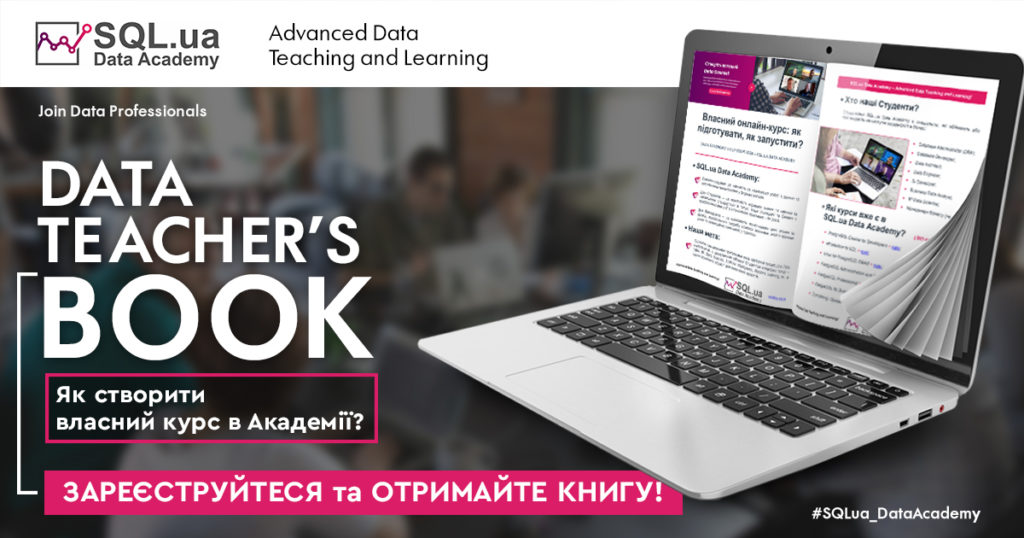
Introduction to Data Science
Інформаційна сторінка для потенційних викладачів курсу
Попередня програма курсу:
Перегляньте нашу статтю з інформацією про визначення ролі дата-вченого, та які навички необхідні:
Що є “Data Science”? Хто є “Data Scientist”?
Модуль 1
Welcome: Introduction to Data Science Course – The Science of Uncertainty and Data
– Огляд програми;
– Знайомство з Викладачами;
– Вступ до тем курсу;
– Data Science mindset – переналаштування мишлення людини, яка планує стати Data Scientist;
– Top Hard and Soft-skills to Develop;
– The Data Scientist’s Toolbox and Ideas;
– Домашні завдання (матеріали для вивчення) + можливо, ДЗ по знайденню/формуванню датасетів для роботи.
Модуль 2
Python for Data Science and Machine Learning
– Python – Basic to Advanced;
– Python for Data Analysis;
– Python for Data Visualization – Applied Plotting, Charting & Data Representation in Python.
Модуль 3
Pandas, SQL and the Grammar of Data
– SQL – Basic to Advanced;
– Identify a subset of data needed from a column or set of columns and write a SQL query to limit to those results.
– Using SQL commands to filter, sort, and summarize data.
– Creating an analysis table from multiple queries using the UNION operator.
– Manipulating strings, dates, & numeric data using functions to integrate data from different sources into fields with the correct format for analysis.
Модуль 4
Getting (Mining), Cleaning and Classifying Data
– Tools for Data Mining;
– APIs and Web Scraping;
– Obtaining Data from Web;
– Obtaining Data from APIs;
– Obtaining Data from Databases;
– Obtaining Data from business users (company departments/functions);
– Data cleaning approaches and tools;
– Data Classification and Clustering.
Модуль 5
Data Analysis on various domain examples
– Intuition behind probability and statistical analysis;
– Key Techniques for Summarizing Data;
– Developing complex statistical models;
– Exploratory techniques to eliminate and sharpen potential hypotheses;
– Basic Principles of Constructing Data Graphics;
– Applied Analysis in __ (domains);
– Applied Social Network Analysis in Python;
– Techniques for Data Visualization – Performing Market Analysis.
Модуль 6
Data Modeling
– Supervised/Unsupervised Learning and Model Evaluation;
– Feature Selection, Engineering, and Data Pipelines;
– Improving statistical modelling skills;
– Advanced Model Evaluation and Data Pipelines | Presentations.
Модуль 7
Practical Machine Learning with Python
– Introduction to ML for Coders;
– Understanding the Mechanics of Machine Learning;
– Linear classifiers, separability, perceptron algorithm;
– Regression, K-Means;
– Decision Trees and Random Forests;
– SVM, Evaluation;
– Predicting Market Changes – ML models building examples;
– Ensemble Methods;
– Best Practices;
– How to Lead successful ML projects.
Модуль 8
Natural Language Processing with Python
– What is Natural Language Processing?
– Recognizing Natural Language Processing Applications;
– Understanding NLP Tasks;
– Spacy basics;
– Tokenization;
– Stemming and POS Tagging;
– Lemmatization;
– Stop Words and removing;
– Phrase Matching and Vocabulary;
– NLP Basics Assessment;
– Text classification – Metrics, confusion matrix;
– Text classification code;
– Text classification assessment solutions;
– Understanding Types of ML Problems in NLP;
– Topic Modeling.
Модуль 9
Neural Nets and Deep Learning
– Introduction to Deep Learning as skill in tech;
– Learn to set up ML problem with neural network mindset;
– Learning features;
– Convolutional networks, RNNs, LSTM, Adam, Dropout, BatchNorm, Xavier/He initialization;
– Shallow neural networks – learning to build;
– Learning to control: Reinforcement learning;
– Case studies in domains.
Модуль 10
Presentation and Storrytelling with Data
– Why learn Data Storytelling;
– Storytelling and Effective Communication;
– Understanding key requests (needs) of data final users;
– The structure of storytelling with data;
– Data storytelling tips.
Модуль 11
Developing Data Products – Practical Cases of Student (Mini-Examination)
Модуль 12
Next Study Steps Overview – What to Learn for Efficient Work in Certain Domain
Критерії кращого курсу по Data Science
- Курс охоплює весь процес Data Science;
- У курсі використовуються популярні open-source інструменти програмування та бібліотеки;
- Викладачі висвітлюють основні, найпопулярніші алгоритми машинного навчання;
- Курс має гарне поєднання теорії та практичного застосування;
- Є практичні завдання та проєкти;
- Викладачі вміють зацікавити та залучити Студента до навчання.
Топ-навички в галузі Data Science

Джерело: за матеріалами Udacity
Відкриті питання по курсу:
– Актуальна програма Курсу;
– Набір Викладачів для Курсу;
– Визначення точного рівня знань (підготовки), з якими Студент має приходити на Курс, що він/вона повинні вже вміти і знати.
Студент до курсу вже має навички:
- Codding skills – вміє програмувати, добре володіє Python та SQL, іншими мовами за потреби.
- Mathematical/Statistical skills.
- Analytic skills.
Вебінар для Викладачів курсу
Теми обговорення:
- Data Science: останні тенденції галузі у застосуванні до реальних проєктів.
- Вчений в галузі даних (Data Scientist) – роль, вимоги, обов’язки, кар’єра.
- Data Skills Set – які навички знадобляться дата-саєнтисту, та з чого почати?
- Як знайти роботу вченого по даним – про що питають на співбесіді, які завдання дають, що стане перевагою кандидата.
- Use-cases – приклади проєктів Data Science у різних доменних областях.
- “Бути Data Scientist” – реалії професії, про які ніхто не говорить вголос.
- Відповіді на питання Учасників Data Talks.
Як підготувати курс? Книга Викладача
Зміст книги:
– Хто ми, як Data Academy, та яка мета;
– Хто наші Студенти;
– Хто наші Викладачі та Спікери;
– Які теми пропонувати;
– Який план (7 кроків) для створення власного курсу;
– Від Вас – контент та якісний супровід Студентів. Всі інше – робимо ми;
– Як стартувати з мінімальними витратами часу з «пілотним курсом»;
– Яке обладнання використовувати для запису курсу;
– Яке ПО потрібне для запису курсу (відео-лекції);
– Як налаштуватися та як знайти мотивацію, коли і так дуже зайняті.


